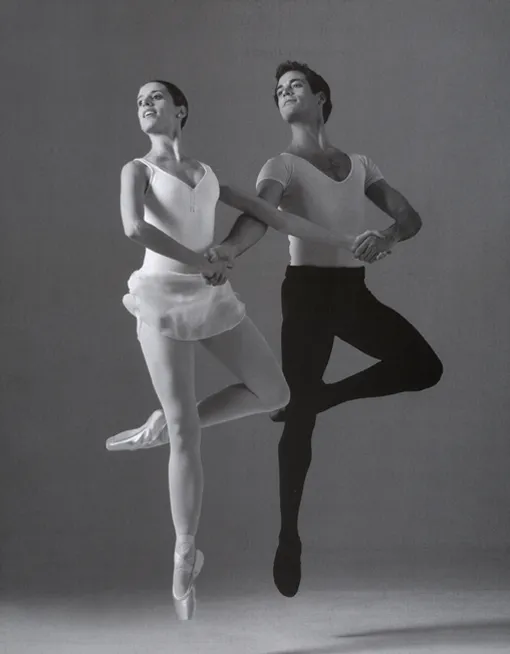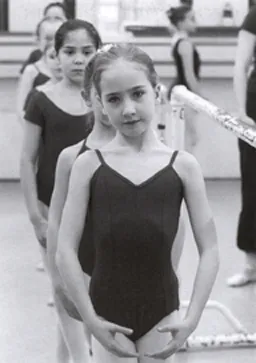Sauté in a modified retiré.
Selecting a Ballet School
Your mother says you danced in the crib. You love moving to music. Perhaps you want to perform. Perhaps performing is not for you, but the exhilaration of a well-executed tour jeté in class is. Perhaps you’ve been advised to try it for medical reasons, to make you strong or improve your posture. Or maybe, like Alexandra Ansanelli, principal dancer at the New York City Ballet, you were knocked out cold on the soccer field and your parents wanted you in something safer. Whatever draws you to ballet, finding the right school will make all the difference to your experience.
In the United States anyone can hang out a shingle and call him-or herself a ballet teacher. There is no organization or governing body to license teachers and maintain standards. But there are many indicators of a school’s merits. Here are some things to look for when considering where to study, many of which are described in more detail later in this book:
1. Teacher’s Credentials
The instructor with the most glamorous and prestigious performing credentials may not be the best teacher. The ability to dance brilliantly is different from the skills that make a great teacher: the ability to analyze, to break down steps, to explain, to inspire. Some people possess both performing and teaching abilities; some don’t.
In France no one is allowed to teach without a state diploma. In the United States, the Cecchetti Society, the Cecchetti Council of America, and the London-based Royal Academy of Dance (R.A.D.) are highly respected institutions whose founders cared deeply about how ballet is taught. Teachers who have been trained through these organizations have learned a well-established syllabus—a known commodity with a proven track record of providing safe, solid, classical training. These are by no means the only good choices. There are other major training systems (seeMajor Schools of Ballet, page 63 ) that certainly produce excellent teachers, too. Don’t be shy about asking about your teachers’ backgrounds.
2. Pure Classical Ballet Technique
A school that offers nonballet classes such as jazz, modern, or tap is a plus, but it you want to learn ballet, the school’s focus should be on classical ballet technique. Your classes should be pure ballet, not a hybrid.
3. Progressive Training Syllabus
Before attempting the thirty-two fouettés in Swan Lake you must master the single pirouette, but before you can do that you must be able to balance in retiré on demi-pointe, and to do that you must have developed control of your turnout. In the best schools, students progress from one level to the next by mastering skills in a logical order. Ideally your school follows a graded syllabus that is informed, at least in part, by the philosophy of one of the major training systems. A syllabus helps ensure that nothing is left out and that there is a solid foundation of strength and technique on which to build in a safe, sensible way.
Some schools divide students into many levels; often each has its own leotard color, and the higher levels usually require more frequent attendance. The R.A.D. and Cecchetti systems offer examinations that students pass before moving up to the next grade. Other schools are more informal, have looser attendance requirements, and simply designate students as beginner, intermediate, or advanced. The important thing is careful, progressive training in a pleasant environment in which you are comfortable.
4. Attitude
A ballet school should exude a disciplined and serious but cheerful atmosphere. (SeeWhat Class Expects of You, page 11 .) Students should be well groomed, neatly dressed, and display good studio etiquette. Sweatpants and other loose, concealing garb should not be allowed. (SeeStudio Attire, page 11 .)
5. Forcing Turnout and Extension
Rotation of the leg in the hip socket so that the knees and feet point out to the side rather than to the front is essential for classical ballet. A turnout of 180 degrees is most desirable but rarely achieved. Forcing it can damage knees, hips, or ankles. A careful teacher will try to help her students achieve the desired flexibility by working within the range of a student’s potential turnout and without putting the joints at risk. If students are struggling to achieve a perfect heel-to-toe-toe-to-heel fifth position, and are unable to straighten their knees or hold the knees over the toes correctly, they are forcing turnout. (SeeAlignment, page 78 .)
6. Pointe Shoes
At what age are the girls allowed to go on pointe? Starting too young can cause injury; a lot of very little girls in pointe shoes is a red flag. Ideally pointe class is not an option but, at the appropriate level, part of the training. (SeeWhen to Begin Pointework, page 17 .)
7. Facilities
The ideal space is large, open, airy, well ventilated, with high ceilings, a good floor, no obstructing pillars or pipes, and plenty of mirrors. The best studio floors are “sprung” (meaning there is air space underneath) wood and covered with a nonslip surface. Things should be clean and neat, especially the dressing rooms. A piano indicates a real accompanist instead of recorded music. This can be a tremendous enhancement, though not a requisite; plenty of schools do just fine with recorded music.
8. Health and Safety
Good ballet training improves your body and your self-esteem. Bad training can have the opposite effect. Beware of a teacher who pooh-poohs health and injury prevention; she may well have a long, sad history of injured pupils. If most of the class has tendinitis at the end of term, think twice about what’s going on. Sick or injured dancers can neither create art nor experience the joy of dancing.
9. Weight
When assessing the health and safety-consciousness of a school, ask yourself whether the students look happy and healthy. Are they lean, bright-eyed, and eager, or are they frighteningly thin and joyless? How much emphasis is being placed on being thin? (SeeBody Esteem, page 214 .)
10. Competition
Is the emphasis on progressive training or on competitions? Performing experience is valuable and should be encouraged, but in the long run an overemphasis on rehearsing for a competition can be a distraction from building solid technique.
Choosing Your Level of Commitment
You get out of ballet what you put into it. Ballet rewards both the ballerina who basks in a standing ovation at Lincoln Center and the ardent amateur who is thrilled to have just done her first double piqué turn. If your ambition is to become a professional dancer, your training will follow a certain exceptionally rigorous path—especially if you hope to dance classical ballet roles with a major company. If you are reconciled to not dancing Swan Lake at Covent Garden but still entertain the idea of a dance career, then you have a little more flexibility in the number and in the types of classes you choose. If you are lucky enough to study ballet for the sheer joy of it, and because there is nothing like the satisfaction of having had a terrific class, then you have more options still.
Many schools offer performance opportunities in recitals, workshops, or, often, a production of The Nutcracker. These can be great fun, and wonderful experiences. But be warned that auditions, rehearsals, and performances add significantly to the amount of time that you devote to ballet. Sometimes there are extra costs, too, such as costume rentals or new pointe shoes. Some schools require that you attend a minimum number of classes each week in order to participate. And if you do, you will be expected to be at every rehearsal and every performance.
Girls with professional aspirations, at about age twelve, usually in the third or fourth year of training, take class five or six days a week, often more than one class a day. Or they may put in the same number of hours with longer classes over fewer days. That’s a lot of time and still more if there are rehearsals, too, plus the daily trek to and from the studio. Serious preprofessional training is also expensive. In addition to tuition there is the cost of practice clothes, shoes, and perhaps summer programs as well.
Young dancers at Ballet Academy East in New York City.
To make it to the highest levels in professional ballet, you should be dancing full time during the years when most people finish high school and go to college. Ballet careers are short, and those years are formative and crucial: your youthful vigor, resilience, and strength are at their peak, your body can best absorb advanced ballet technique and you can most easily adapt to an artistic director’s vision and a company’s style. This presents a difficult choice for dancers’ parents (usually the dancer knows that there is nothing in the world she would rather do than dance).
Forgoing or postponing higher education is not always a requisite for a professional career. Many colleges and universities offer excellent dance programs, some with prominent choreographers in residence. Conservatories such as Juilliard produce world-class dancers who also have solid academic backgrounds. Modern dancers can often start later than ballet dancers, as can musical theater dancers. Plenty of companies require that their dancers have a good command of ballet but not that they be virtuosi—either because the repertory is not the most technically demanding or because it is not limited to ballet. Being a charismatic performer who can also handle modern or jazz sometimes counts for more than pure ballet technique.
Top-notch training and all the other benefits of ballet are available even to dancers without professional ambitions. Many schools, including some professional conservatories with “open divisions” (programs that do not require you to commit to the preprofessional track and allow you to enroll in fewer classes), offer excellent classes for students who want to dance for the sake of dancing. Most schools don’t turn away the once-a-week dancer; just know that it isn’t realistic to expect progress beyond the basics if that’s all the time you can allow. To improve your technique, you must take at least two classes a week. Three is better. Most schools require regular attendance at several classes a week in order to begin pointework.
Even if you don’t intend to dance professionally, there are reasons to make the commitment to frequent if not daily classes. Ballet class gives your day structure and focus. Patient, daily study pays off not only in what it does for your technique. The applied discipline it takes will help you tackle other tasks in other areas of your life. It makes you stand out on college applications, too. But watch out: ballet class can be addictive. You may find that your problem isn’t taking too few classes but wanting to take too many.


